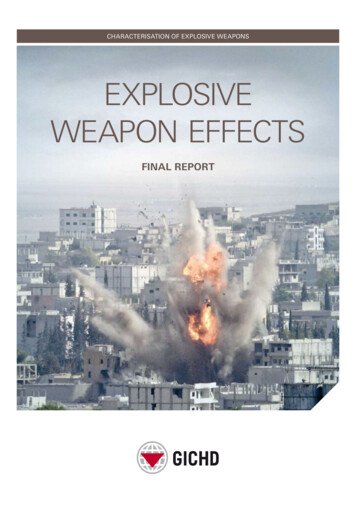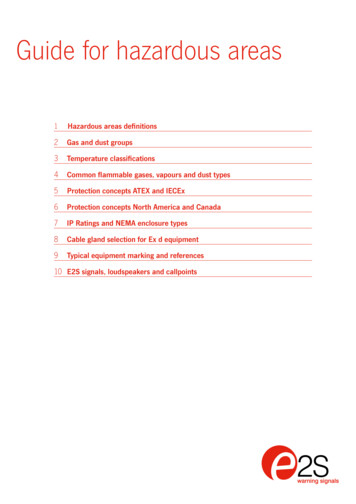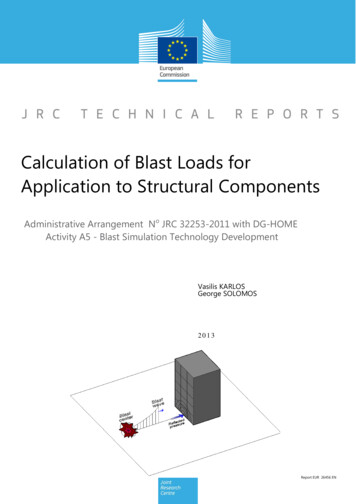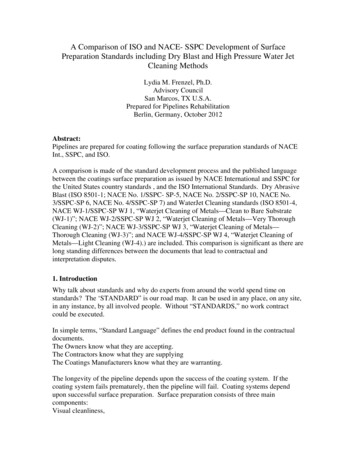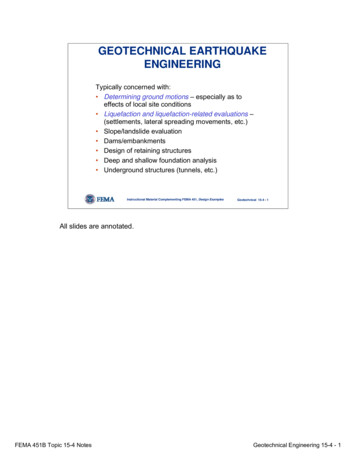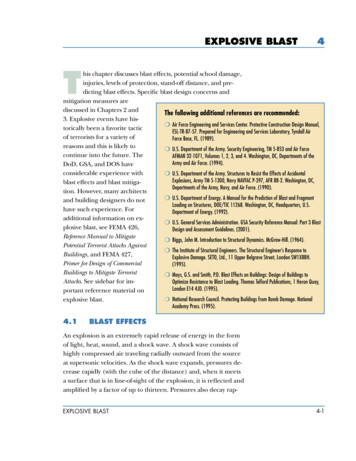
Transcription
EXPLOSIVE BLAST4This chapter discusses blast effects, potential school damage,injuries, levels of protection, stand-off distance, and predicting blast effects. Specific blast design concerns andmitigation measures arediscussed in Chapters 2 andThe following additional references are recommended:3. Explosive events have his Air Force Engineering and Services Center. Protective Construction Design Manual,torically been a favorite tacticESL-TR-87-57. Prepared for Engineering and Services Laboratory, Tyndall Airof terrorists for a variety ofForce Base, FL. (1989).reasons and this is likely to U.S. Department of the Army. Security Engineering, TM 5-853 and Air Forcecontinue into the future. TheAFMAN 32-1071, Volumes 1, 2, 3, and 4. Washington, DC, Departments of theArmy and Air Force. (1994).DoD, GSA, and DOS haveconsiderable experience with U.S. Department of the Army. Structures to Resist the Effects of AccidentalExplosions, Army TM 5-1300, Navy NAVFAC P-397, AFR 88-2. Washington, DC,blast effects and blast mitigaDepartments of the Army, Navy, and Air Force. (1990).tion. However, many architects U.S. Department of Energy. A Manual for the Prediction of Blast and Fragmentand building designers do notLoading on Structures, DOE/TIC 11268. Washington, DC, Headquarters, U.S.have such experience. ForDepartment of Energy. (1992).additional information on ex U.S. General Services Administration. GSA Security Reference Manual: Part 3 Blastplosive blast, see FEMA 426,Design and Assessment Guidelines. (2001).Reference Manual to Mitigate Biggs, John M. Introduction to Structural Dynamics. McGraw-Hill. (1964).Potential Terrorist Attacks Against The Institute of Structural Engineers. The Structural Engineer’s Response toBuildings, and FEMA 427,Explosive Damage. SETO, Ltd., 11 Upper Belgrave Street, London SW1X8BH.Primer for Design of Commercial(1995).Buildings to Mitigate Terrorist Mays, G.S. and Smith, P.D. Blast Effects on Buildings: Design of Buildings toAttacks. See sidebar for imOptimize Resistance to Blast Loading. Thomas Telford Publications, 1 Heron Quay,London E14 4JD. (1995).portant reference material on National Research Council. Protecting Buildings from Bomb Damage. Nationalexplosive blast.Academy Press. (1995).4.1BLAST EFFECTSAn explosion is an extremely rapid release of energy in the formof light, heat, sound, and a shock wave. A shock wave consists ofhighly compressed air traveling radially outward from the sourceat supersonic velocities. As the shock wave expands, pressures decrease rapidly (with the cube of the distance) and, when it meetsa surface that is in line-of-sight of the explosion, it is reflected andamplified by a factor of up to thirteen. Pressures also decay rapEXPLOSIVE BLAST4-1
idly over time (i.e., exponentially) and have a very brief span ofexistence, measured typically in thousandths of a second, or milliseconds. Diffraction effects, caused by corners of a building, mayact to confine the air-blast, prolonging its duration. Late in theexplosive event, the shock wave becomes negative, creating suction. Behind the shock wave, where a vacuum has been created,air rushes in, creating a powerful wind or drag pressure on all surfaces of the building. This wind picks up and carries flying debrisin the vicinity of the detonation. In an external explosion, a portion of the energy is also imparted to the ground, creating a craterand generating a ground shock wave analogous to a high-intensity,short-duration earthquake.In the context of other hazards (e.g., earthquakes, winds, or floods),an explosive attack has the following distinguishing features: The intensity of the pressures acting on a targeted buildingcan be several orders of magnitude greater than these otherhazards. It is not uncommon for the peak pressure to be inexcess of 100 pounds per square inch (psi) on a building in anurban setting for a vehicle weapon parked along the curb. Atthese pressure levels, major damages and failure are expected. Explosive pressures decay extremely rapidly with distancefrom the source. Therefore, the damages on the side of thebuilding facing the explosion may be significantly more severethan on the opposite side. As a consequence, direct air-blastdamages tend to cause more localized damage. The duration of the event is very short, measured inthousandths of a second, or milliseconds. This differs fromearthquakes and wind gusts, which are measured in seconds,or sustained wind or flood situations, which may be measuredin hours. Because of this, the mass of the structure has astrong mitigating effect on the response because it takes timeto mobilize the mass of the structure. By the time the mass ismobilized, the loading is gone, thus mitigating the response.This is the opposite of earthquakes, whose imparted forces areroughly in the same timeframe as the response of the buildingmass, causing a resonance effect that can worsen the damage.4-2EXPLOSIVE BLAST
4.1.1Building DamageThe extent and severity of damage and injuries in an explosiveevent cannot be predicted with perfect certainty. Past events showthat the unique specifics of the failure sequence for a building significantly affect the level of damage. Despite these uncertainties, itis possible to give some general indications of the overall level ofdamage and injuries to be expected in an explosive event, basedon the size of the explosion, distance from the event, and assumptions about the construction of the building.Damage due to the air-blast shock wave may be divided into directair-blast effects and progressive collapse. Direct air-blast effectsare damage caused by the high-intensity pressures of the air-blastclose in to the explosion and may induce the localized failure ofexterior walls, windows, floor systems, columns, and girders. Progressive collapse is discussed in Section 3.2.The air-blast shock wave is the primary damage mechanism in anexplosion. The pressures it exerts on building surfaces may beseveral orders of magnitude greater than the loads for which thebuilding is designed. The shock wave also acts in directions thatthe building may not have been designed for, such as upward onthe floor system. In terms of sequence of response, the air-blastfirst impinges on the weakest point in the vicinity of the deviceclosest to the explosion, typically the exterior envelope of thebuilding. The explosion pushes on the exterior walls at the lowerstories and may cause wall failure and window breakage. As theshock wave continues to expand, it enters the structure, pushingboth upward and downward on the floors (see Figure 4-1).Floor failure is common in large-scale vehicle-delivered explosiveattacks, because floor slabs typically have a large surface area forthe pressure to act on and a comparably small thickness. In termsof the timing of events, the building is engulfed by the shockwaveand direct air-blast damage occurs within tens to hundreds of milliseconds from the time of detonation. If progressive collapse isinitiated, it typically occurs within seconds.EXPLOSIVE BLAST4-3
Figure 4-1Blast pressure effects on a structureGlass is often the weakest part of a building, breaking at low pressures compared to other components such as the floors, walls,or columns. Past incidents have shown that glass breakage mayextend for miles in large external explosions. High-velocity glass4-4EXPLOSIVE BLAST
fragments have been shown to be a major contributor to injuriesin such incidents. For incidents within downtown city areas, fallingglass poses a major hazard to passersby on the sidewalks below andprolongs post-incident rescue and cleanup efforts by leaving tonsof glass debris on the street. Specific glazing design considerationsare discussed in Chapter 3.4.1.2Casualties and InjuriesBlast can cause significant casualties. During the bombing of theMurrah Federal Building, 168 people were killed. Severity andtype of injury patterns incurred in explosive events may be related to the level of structural damage. The high pressure of theair-blast that enters through broken windows can cause eardrumdamage and lung collapse. As the air-blast damages the buildingcomponents in its path, missiles are generated that cause impactinjuries. Airborne glass fragments typically cause penetration orlaceration-type injuries. Larger fragments may cause non-penetrating, or blunt trauma, injuries. Finally, the air-blast pressurescan cause occupants to be bodily thrown against objects or to fall.Lacerations due to high-velocity flying glass fragments have beenresponsible for a significant portion of the injuries received in explosion incidents. In the bombing of the Murrah Federal Buildingin Oklahoma City, for instance, 40 percent of the survivors in thebuilding cited glass as contributing to their injuries. Within nearbybuildings, laceration estimates ranged from 25 percent to 30 percent.4.1.3Levels of ProtectionThe amount of explosive and the resulting blast dictate the levelof protection required to prevent a building from collapsing orminimize injuries and deaths. Table 4-1 shows how the DoD correlates levels of protection with potential damage and expectedinjuries. The GSA and the Interagency Security Committee (ISC)also use the level of protection concept. However, wherein DoDhas five levels, they have established four levels of protection. TheGSA and ISC levels of protection can be found in GSA PBS-P100,Facilities Standards for the Public Buildings Service, November 2000,Section 8.6.EXPLOSIVE BLAST4-5
Table 4-1: DoD Minimum Antiterrorism (AT) Standards for New BuildingsLevel ofProtectionBelow ATstandardsVery LowLowMediumHighPotential Structural DamagePotential Door and GlazingHazardsSeverely damaged – frame collapse/massivedestruction. Little left standing.Doors and windows fail and result inlethal hazardsMajority of personnelsuffer fatalities.Heavily damaged – onset of structuralcollapse. Major deformation of primaryand secondary structural members, butprogressive collapse is unlikely. Collapse ofnon-structural elements.Glazing will break and is likely to bepropelled into the building, resultingin serious glazing fragment injuries,but fragments will be reduced.Doors may be propelled into rooms,presenting serious hazards.Majority of personnelsuffer serious injuries.There are likely to bea limited number (10percent to 25 percent)of fatalities.Damaged – unrepairable. Major deformationof non-structural elements and secondarystructural members and minor deformation ofprimary structural members, but progressivecollapse is unlikely.Glazing will break, but fall within1 meter of the wall or otherwisenot present a significant fragmenthazard. Doors may fail, but theywill rebound out of their frames,presenting minimal hazards.Majority of personnelsuffer significantinjuries. There may bea few ( 10 percent)fatalities.Damaged – repairable. Minor deformationsof non-structural elements and secondarystructural members and no permanentdeformation in primary structural members.Glazing will break, but will remainin the window frame. Doors will stayin frames, but will not be reusable.Some minor injuries,but fatalities areunlikely.Superficially damaged. No permanentdeformation of primary and secondarystructural members or non-structuralelements.Glazing will not break. Doors will bereusable.Only superficial injuriesare likely.Potential InjurySOURCE: THE DoD UNIFIED FACILITIES CRITERIA (UFC), DoD MINIMUM ANTITERRORISM STANDARDS FOR BUILDINGS, UFC 4-010-01, 31 JULY 2002The levels of protection above can roughly be correlated forconventional construction without any blast hardening to the following incident pressures as shown in Table 4-2.Table 4-2: Correlation of DoD Level of Protection to Incident Pressure4-6Level of ProtectionIncident Pressure (psi)High1.1Medium1.8Low2.3EXPLOSIVE BLAST
Figure 4-2 shows an example of a range-to-effect chart that indicates the distance or stand-off to which a given size bomb willproduce a given effect (see Section 4.2). This type of chart canbe used to display the blast response of a building componentor window at different levels of protection. It can also be used toconsolidate all building response information to assess needed actions if the threat weapon-yield changes. For example, an amountof explosives are stolen and indications are that they may be usedagainst a specific building. A building-specific range-to-effectchart will allow quick determination of the needed stand-off forthe amount of explosives in question, once the explosive weightis converted to trinitrotoluene (TNT) equivalence. Given an explosive weight and a stand-off distance, Figure 4-2 can be used topredict damage for nominal building construction.For design purposes, large scale truck bombs typically contain10,000 pounds or more of TNT equivalent, depending on the sizeand capacity of the vehicle used to deliver the weapon. Vehiclebombs that utilize vans down to small sedans typically contain 4,000to 500 pounds of TNT equivalent, respectively. A briefcase bombis approximately 50 pounds, and a pipe bomb is generally in therange of 5 pounds of TNT equivalent. Research performed as partof the threat assessment process should identify bomb sizes used inthe locality or region. Security consultants have valuable information that may be used to evaluate the range of likely charge weights.Figures 4-3 and 4-4 show blast effects predictions for a high schoolbased on a typical car bomb, and a typical large truck bomb detonated in the school’s parking lot, respectively. A computer-basedGIS was used to analyze the school’s vehicular access and circulation pattern to determine a reasonable detonation point for avehicle bomb. Structural blast analysis was then performed usingnominal explosive weights and a nominal school structure. Theresults are shown in Figures 4-3 and 4-4. The red ring indicatesthe area in which structural damage is predicted. The orange andyellow rings indicate predictions for lethal injuries and severe injuries from glass, respectively. Please note that nominal inputs wereused in this analysis and they are not a predictive examination.EXPLOSIVE BLAST4-7
SOURCE: DEFENSE THREAT REDUCTION AGENCYFigure 4-24-8Explosives environments - blast range to effectsEXPLOSIVE BLAST
Figure 4-3Blast analysis of a high school for a typical car bomb detonated in the school’s parking lotFigure 4-4Blast analysis of a high school for a typical large truck bomb detonated in the school’sparking lotEXPLOSIVE BLAST4-9
In the case of a stationary vehicle bomb, knowing the size of thebomb (TNT equivalent in weight), its distance from the structure,how the structure is put together, and the materials used for walls,framing, and glazing allows the designer to determine the levelof damage that will occur and the level of protection achieved.Whether an existing building or a new construction, the designercan then select mitigation measures as presented in this chapterand Chapters 2 and 3 to achieve the level of protection desired.4.2STAND-OFF DISTANCE AND THE EFFECTSOF BLASTEnergy from a blast decreases rapidly over distance. In general,the cost to provide asset protection will decrease as the distancebetween an asset and a threat increases, as shown in Figure 4-5.However, increasing stand-off also requires more land and moreperimeter to secure with barriers, resulting in an increased costnot reflected in Figure 4-5. As stand-off increases, blast loads generated by an explosion decrease and the amount of hardeningnecessary to provide the required level of protection decreases.Figure 4-5 Relationship of cost to stand-off distanceSOURCE: U.S. AIR FORCE, INSTALLATION FORCE PROTECTION GUIDE4-10EXPLOSIVE BLAST
The critical location of the weapon is a function of the site, thebuilding layout, and the security measures in place. For vehiclebombs, the critical locations are considered to be at the closestpoint that a vehicle can approach on each side, assuming that allsecurity measures are in place. Typically this is a vehicle parkedalong the curb directly outside the building, or at the entry control point where inspection takes place. For internal weapons,location is dictated by the areas of the building that are publiclyaccessible (e.g., lobbies, corridors, auditoriums, cafeterias, orgymnasiums). Range or stand-off is measured from the center ofgravity of the charge located in the vehicle or other container tothe building component under consideration.Defining appropriate stand-off distance for a given building component to resist explosive blast effects is difficult. Often in urbansettings, it is either not possible or practical to obtain appropriatestand-off distance. Adding to the difficulty is the fact that definingappropriate stand-off distance requires a prediction of the explosive weight of the weapon. In the case of terrorism, this is tenuousat best.The DoD prescribes minimum stand-off distances based on therequired level of protection. Where minimum stand-off distancesare met, conventional construction techniques can be used withsome modifications. In cases where the minimum stand-off cannotbe achieved, the building must be hardened to achieve the required level of protection (see the DoD UFC – DoD MinimumAntiterrorism Standards for Buildings, UFC 4-010-01, 31 July 2002).The first step in predicting blast effects on a building is to predictblast loads on the structure. Because blast pressure pulse variesbased on stand-off distance, angle of incidence, and reflectedpressure over the exterior of the building, the blast load predictions can be very complex. Consultants may use sophisticatedmethods such as Computational Fluid Dynamics (CFD) computerprograms to predict blast loads. These complex programs requirespecial equipment and training to run.EXPLOSIVE BLAST4-11
In most cases, especially for design purposes, more simplifiedmethods may be used by blast consultants to predict blast loads.Tables of pre-determined values (see GSA Security Reference Manual:Part 3 – Blast Design & Assessment Guidelines, July 31, 2001) or computer programs may be used such as: 1 ATBLAST (GSA) CONWEP (U.S. Army Engineer Research and DevelopmentCenter)Figure 4-6 provides a quick method for predicting the expectedoverpressure (expressed in pounds per square inch or psi) on abuilding for a specific explosive weight and stand-off distance.Enter the x-axis with the estimated explosive weight a terroristmight use and the y-axis with a known stand-off distance from abuilding. By correlating the resultant effects of overpressure withother data, the degree of damage that the various components ofa building might receive can be estimated. The vehicle icons inFigure 4-6 indicate the relative size of the vehicles that might beused to transport various quantities of explosives.The analysis of structures subjected to the effects of an explosion is very complex and requires an understanding of structuralengineering, dynamics, strengths of materials, and specializedtraining in explosive effects. Such analysis should be performed byengineers who can conduct a complex analysis that is both timedependent and accounts for non-linear behavior. In the absenceof such an analysis of a specific structure, it is possible to providerough approximations of building damages to be expected in an explosive event. Table 4-3 provides basic estimates of incident pressuresat which different types of damage generally occur to buildings basedon the incident pressures determined in Figure 4-6.14-12For security reasons, the distribution of these computer programs is limited.EXPLOSIVE BLAST
SOURCE: U.S. AIR FORCE, INSTALLATION FORCE PROTECTION GUIDEFigure 4-6Incident overpressure measured in pounds per square inch, as a function of stand-offdistance and net explosive weight (pounds-TNT)Table 4-3: Damage ApproximationsDamageTypical window glass breakageIncident Overpressure (psi)0.15 – 0.22Minor damage to some buildings0.5 – 1.1Panels of sheet metal buckled1.1 – 1.8Failure of concrete block walls1.8 – 2.9Collapse of wood framed buildingsOver 5.0Serious damage to steel framed buildings4–7Severe damage to reinforced concrete structures6–9Probable total destruction of most buildings10 – 12SOURCES: EXPLOSIVE SHOCKS IN AIR, KINNEY & GRAHM, 1985; FACILITY DAMAGE AND PERSONNEL INJURY FROM EXPLOSIVE BLAST,MONTGOMERY & WARD, 1993; AND THE EFFECTS OF NUCLEAR WEAPONS, 3RD EDITION, GLASSTONE & DOLAN, 1977.EXPLOSIVE BLAST4-13
EXPLOSIVE BLAST 4 EXPLOSIVE BLAST 4-1 This chapter discusses blast effects, potential school damage, injuries, levels of protection, stand-off distance, and pre-

